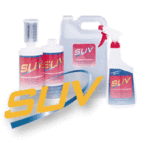The US Occupational Safety and Health Administration (OSHA) has specific requirements for sharps containers in…
EPA’s Labeling Requirements for Surface Disinfectants – Dental Disinfectants
In the United States, under the authority of the Federal Insecticide, Fungicide, and Rodenticide Act (FIFRA), the Environmental Protection Agency (EPA) has sole responsibility to establish the rules for efficacy claims and safety of surface disinfectants. Under FIFRA, any substance or mixture of substances intended to prevent, destroy, repel, or mitigate any pest (including microorganisms but excluding those in or on living humans or animals) must be registered with EPA before sale or distribution. To obtain a registration, a manufacturer must submit to EPA proposed labeling and specific data about the safety and effectiveness of each product. EPA requires manufacturers of disinfectants to test formulations for microbiocidal activity, stability, and toxicity to animals and humans following strict protocols. If EPA concludes the product can be used without causing “unreasonable adverse effects,” then the product and its labeling are registered, and the manufacturer can sell and distribute the product in the US.
FIFRA also requires users of products to follow explicitly the labeling directions on each product. The following standard statement appears on all labels under the “Directions for Use” heading: “It is a violation of federal law to use this product in a manner inconsistent with its labeling.” This statement means a healthcare worker must follow the safety precautions and use directions on the labeling of each registered product. Failure to follow the specified use-dilution, contact time, method of application, or any other condition of use is considered a misuse of the product and potentially subject to enforcement action under FIFRA.
Additionally, all disinfectants legally sold in the U.S. must provide valid efficacy data for each specific microorganism claim on the label. It is illegal under the FIFRA to make statements, either by the manufacturer or a third party, on a product’s efficacy that is not supported by specific registered label claims.
With respect to tuberculocidals, also referred to as intermediate level disinfectants, tuberculosis efficacy is not an acceptable scientific standard for proving efficacy against other pathogens. As stated above, EPA requires that all products legally sold in the U.S. must have valid efficacy data for each specific microorganism claim on the label. For example, even though a product may be tuberculocidal, a manufacturer cannot claim it to be a “hospital disinfectant” unless it has been specifically tested successfully against Staphylococcus aureus, Salmonella cholerasesuis, and Pseudomonas aeruginosa pathogens. Nor can the manufacturer claim effectiveness against hepatitis B virus or HIV unless the product has been specifically tested successfully against these pathogen. In other words, only claims that are listed on the registered label can be made for a disinfectant’s efficacy.
Therefore, all products legally sold in the U.S. must provide safety precautions and use directions, as well as valid efficacy data for each specific microorganism claim on the label.

OSHA Review, Inc. provides the SUV Disinfectant & Cleaner in both concentrate and ready-to-use wipes. SUV Disinfectant and Cleaner meets OSHA and EPA regulations, and CDC recommendations. SUV is a hospital disinfectant proven effective against HIV, HBV and HCV.
SUV’s special formula contains a powerful cleaning agent, for use as an effective surface cleaner prior to disinfection, as well as an exceptional ultrasonic cleaning solution for cleaning and decontaminating instruments prior to sterilization and vacuum line cleaner to keep your vacuum lines clear of organic debris.


